These days, customers expect companies to offer customer
preferences in order to reduce the buying cycle time and increase the value. With
the increasing number of channels and the need for consistent experience, we
have been hearing about the ever-evolving ‘customer experience’ systems. This journey
from CRM to CEM, marks a shift from an internally focused to externally focused
solution to offer better customer experiences.
In the past, being internally focused gave more time for
companies to adopt and evolve, but in the CEM era, companies don’t have the
same time. The balance is between great customer experience that drives loyalty
and ‘relevant preference’ that will drive commerce. According to a recent
Business2Community article written by Ramesh
Ramakrishnan, a marketing and organization culture enthusiast and author of
www.futuristCMO.com, here are five steps to get the best out of CEM
initiatives:
1. Build seamless
interactions
Customers are expecting seamless interactions across
traditional channels like in-store, call-center, online as well as new channels
like mobile and social. Though technology can play a role in enabling this,
employee (internal) based seamless interactions can really transform customer
(external) based seamless interactions.
2. Deliver consistent
value
Consistent experience across channels due to end-to-end
processes, functionality rich channel systems, de-centralization to harness
channel incubation, management commitment offers a chance for customers to build
trust. Flexible and functionality rich solutions across fast moving channels
such as social, mobile will help companies deliver consistently in a fast paced
environment.
3. Offer relevant
preferences using real-time approaches
Connecting the customer transaction data, front line
interaction information and non-enterprise data such as social, mobile can help
companies to understand the current and future needs of the customer. Leveraging
big data and analytics to come up with relevant preferences for customers will
be a key differentiator considering the number of alternatives available.
Real-time solutions through big data, analytics, In-memory and human
intelligence will transform commerce and customer experience.
4. Develop a partner
ecosystem that can collaborate
Customer experience management is a cluster of products that
have to work together to offer a holistic solution. It’s critical to have the
right set of partners who are innovators, have a good partner ecosystem, and
are open to integration with other vendor products.
5. Implement Total
Customer Experience (TCE)
In Total Quality Management (TQM), the quality of products is
the responsibility of everyone involved in the creation and consumption
ecosystem. So, TCE should be a philosophy across the entire organization.
Customer experience is not just a front line issue as competition, delays across
departments can badly impact customer experience. In the connected media age
where customers immediately share more of their negative experiences than
positive ones, such negative stories can impact commerce.
Overall, CEM will continue to evolve due to innovation and
customer trends, so companies must create an agile ecosystem.




















.png)
